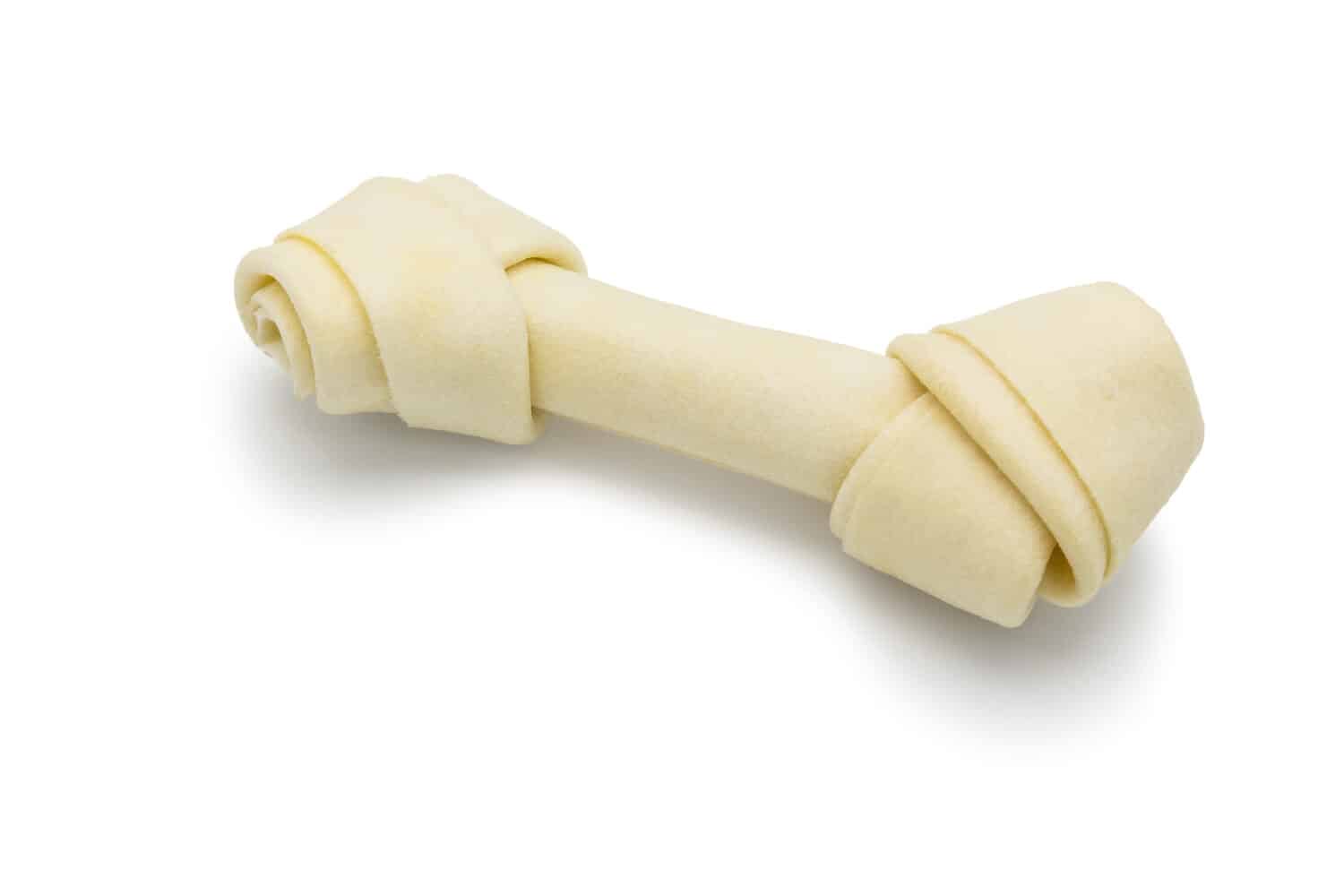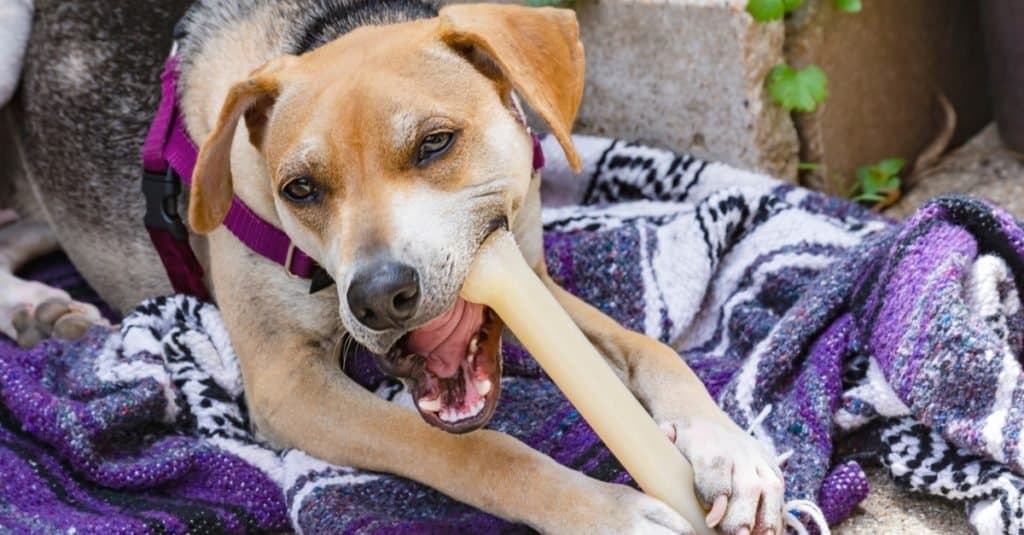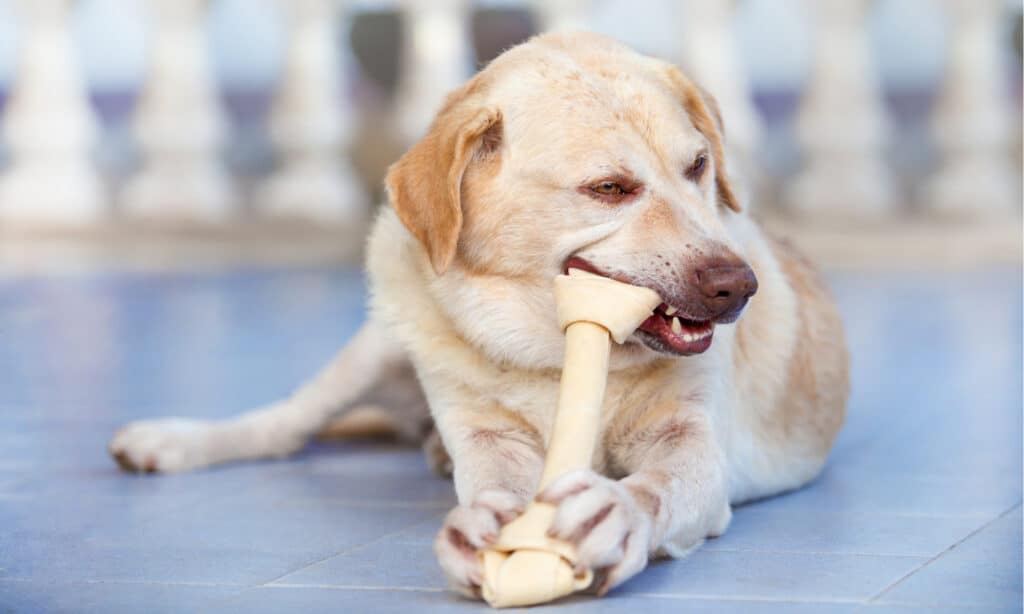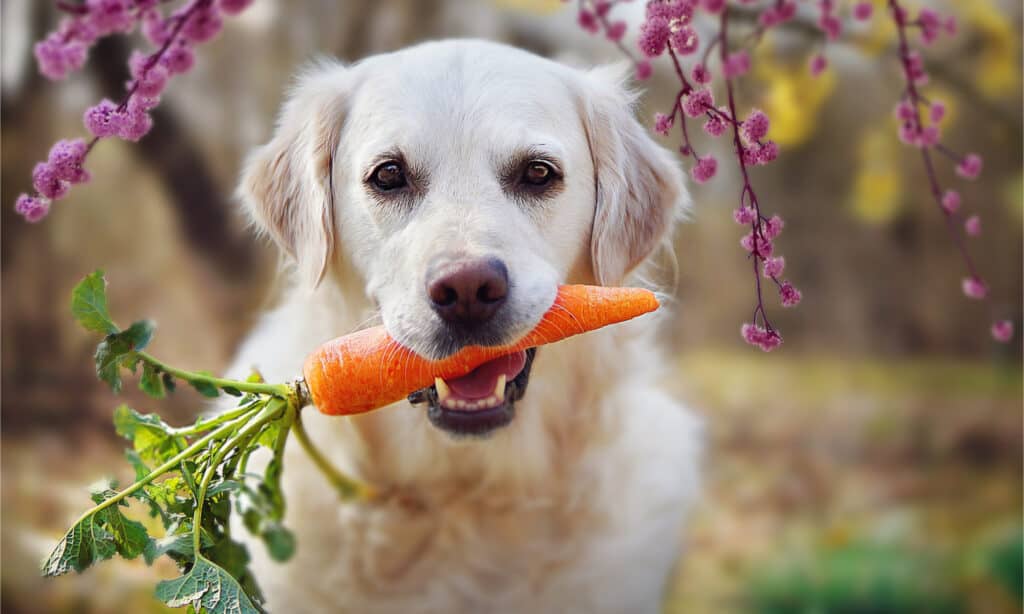When it comes to our furry friends, their health and well-being is a top priority. We lovingly care for them, shower them with affection, and provide them with the best diet. However, there is one common item that many dog owners unknowingly give their pets that can pose a serious risk to their health — rawhide bones.
Reasons to Never Give Dogs Rawhide Bones

Rawhide bones are extremely unhealthy for dogs, for a variety of reasons.
©Jakkrit Orrasri/Shutterstock.com
Here are seven reasons you should never give your dog a rawhide bone. We examine the ingredients, potential dangers of, and alternative options to rawhide bones. Let’s dive in and uncover the truth about this popular but potentially dangerous dog treat.
1. They’re Sourced From Foreign, Substandard Factories
Factories worldwide, from China to Thailand, Korea, and Central America, produce rawhide toys. It is shocking that rawhide manufacturers aren’t obliged to disclose their ingredients’ source. As a result, determining the origin and manufacturing process of a rawhide chew becomes very difficult.
This lack of transparency is especially alarming because most US pet owners are fully aware of the potential hazards of dog treats that overseas factories produce.
2. Rawhide Bones Are Full of Toxins
When turning animal skins into rawhide products, manufacturers add chemicals and toxins at almost every stage. For instance, a toxic cocktail of sodium sulfide removes hair and fur.
Among the dangerous contaminants in rawhide are mercury, lead, insecticides, and antibiotics. Because animal skins and materials compose rawhide, salmonella is a very real and serious concern. Your pet (and you) could potentially contract salmonella from his rawhide.
3. They Contain Spurious Ingredients
In recent years, pet owners have become suspicious and concerned about the ingredients in their dogs’ food and treats, especially when it comes to rawhide bones.
The leather industry’s leftovers make up many rawhide chews. Those leftovers come directly from the kill floors, after which high-salt brines slow their decay. Unfortunately, salt brines cannot prevent decay, no matter how long they delay it.
4. Rawhide Bones Are a Choking Hazard
Rawhide bones and chew toys pose a significant, common risk of choking. The toys have knots at their ends that can lodge in your dog’s throat, causing breathing difficulties. Further, when rawhide softens into a sticky, gooey substance, it becomes a serious choking hazard.
Your pup may be at risk when the slimy parts lodge in the mouth’s roof or deep in the esophagus. Unsurprisingly, rawhide bones and chew toys remain one of the most common reasons pets require emergency veterinary visits.
5. They May Cause Gastrointestinal Damage
Rawhide does not dissolve in a dog’s stomach — in fact, it swells up. Further, rawhide doesn’t completely break down in a dog’s digestive tract. If your dog eats too much rawhide it may result in vomiting.
The material is tough, making it hard to digest, so your dog may spend hours or sometimes days, chewing the bone, ripping it off, and eating only tiny pieces at a time. Some dogs have allergies associated with the rawhide itself or bacteria in the product. Their symptoms may include gastrointestinal irritation, bloating, rashes, and diarrhea.
6. Rawhide Bones May Not Be Digestible
Rawhide is made from the inner layer of animal hides, which is tough and fibrous. Further, dogs’ relatively short digestive systems may be unable to break down the rawhide effectively. The processing methods involved in producing rawhide bones involve treatment with chemicals like bleach or preservatives, which can also be difficult for dogs to digest and may cause digestive issues.
7. They Could Cause Dental Issues
Most rawhide brands are compressed so hard that they could potentially break or fracture your dog’s teeth. Dog gum bleeding is a side effect. Left untreated, broken teeth can lead to infection.
Chewing on rawhide can also cause dog panting, a sign of infection. Don’t let your dog chew on rawhide bones or treats for over an hour daily. Keep a watch for loose teeth, visibly broken or missing teeth, or red, swollen gums.
Rawhide Bones for Dogs: Frequently Asked Questions

Choking in dogs is a common emergency and rawhide bones pose a risk.
©Jennifer Tepp/Shutterstock.com
What Is Rawhide?
Rawhide refers to the hide of an animal that is untanned. Rawhide chew sticks, or rawhide bones, are made from animal hide (usually cows). The hide of the animal is split to make rawhide bones.
Are Rawhide Bones Killing Dogs?
Are rawhide bones dangerous for dogs? The short answer is, ‘It depends’. The safety of any rawhide depends on several factors, including your dog’s chewing style, rawhide ingredients, and digestibility, which can vary from dog to dog.
While rawhide bones are designed to be long-lasting chews that over time break down into soft pieces, strong chewers sometimes break off large chunks. That can be a major choking hazard or result in intestinal blockage, both of which could be life-threatening.
Why Is Rawhide Bad for Dogs?
Rawhide is bad for dogs for several reasons. Rawhide bones can result in dogs choking. In fact, the risk is higher than contamination or digestive irritation. Large pieces of rawhide can get stuck in the esophagus or other parts of the digestive tract when swallowed.
Depending on the size and location of the rawhide pieces, a vet may be able to remove them through endoscopy, a procedure that facilitates the diagnosis of gastrointestinal issues. However, sometimes, abdominal surgery is required to remove the pieces from the stomach or intestines. Failure to resolve the issue and blockages could lead to death.

Rawhide bones could get stuck in a dog’s esophagus
©MaxShutter/Shutterstock.com
Do Vets Recommend Rawhide Bones?
Some veterinarians recommend rawhide chews as a way to improve dogs’ dental health, albeit with a few precautions. Others oppose giving dogs these treats, citing cases where rawhide pieces lodge in the throat or intestines, which requires rushing dogs to the ER vet.
What Age Can Puppies Have Rawhide?
If you want to give puppies rawhide, wait till they are at least 6 months old. Since puppies’ mouths are not fully developed, rawhide could be too hard for them. Puppies will love rawhide during their teething phase, as it could help relieve gum discomfort and assist them in developing strong, flexible jaws.
Alternatives to Rawhide for Dogs
Dried Meat Products
If you don’t want to give your dog raw bones, natural dehydrated meat is a great option. Bully sticks made from bull penises are examples. They may not last as long as a rawhide chew, but they will give your dog some decent chewing activity. Plus, they’re considerably safer and more digestible than rawhide chews.
Pegetables
Pegetables are made from the best veggies for dogs, such as sweet potatoes, peas, and carrots, and are available in most pet stores. These dog chew treats are gluten-, corn- and grain-free and easy to digest. Moreover, they may also clean your fur baby’s teeth and freshen their breath.
Salmon Skin Bones
Is your dog a picky eater? Salmon skin bones may be the alternative to the rawhide bones you’re looking for. As the name suggests, they are bones for dogs that are made of salmon skin! These treats are ideal for dogs with protein sensitivities or allergies and dogs who don’t love their vegetables.
Frozen Carrots

Dogs love frozen carrots and they’re a long-lasting treat.
©Stickler/Shutterstock.com
Looking for a sweet treat your dog will go wild for? These veggie sticks are already tough to chew, and when you put them in the freezer for a couple of hours, they become the perfect long-lasting treat. Bonus: they’re also super low in calories! Win-win!
Summary of Reasons to Never Give a Dog a Rawhide Bone
| Feature | Reason | |
|---|---|---|
| 1. | Factory Source | Determining the source of a rawhide chew is excessively difficult. |
| 2. | Toxins | Rawhide bones often contain toxic chemicals. |
| 3. | Ingredients | Many rawhide bones come from the leather industry’s leftovers. |
| 4. | Choking Hazard | The knots on the end of rawhide bones can pose a risk of choking, as can the gooey substance rawhide becomes after a dog chews it. |
| 5. | Potential for Gastrointestinal Damage | Rawhide bones don’t dissolve, but rather swell, in dogs’ stomachs, which could cause gastrointestinal damage. |
| 6. | Lack of Digestibility | Because dogs have such a short digestive system, they may not digest a rawhide bone properly. |
| 7. | Problematic Texture | Rawhide bones can cause dental problems, such as fractured teeth and bleeding gums. |
Ready to discover the top 10 cutest dog breeds in the entire world?
How about the fastest dogs, the largest dogs and those that are -- quite frankly -- just the kindest dogs on the planet? Each day, AZ Animals sends out lists just like this to our thousands of email subscribers. And the best part? It's FREE. Join today by entering your email below.
Thank you for reading! Have some feedback for us? Contact the AZ Animals editorial team.








